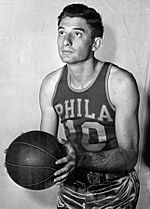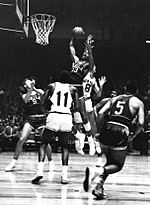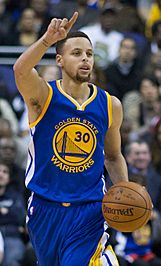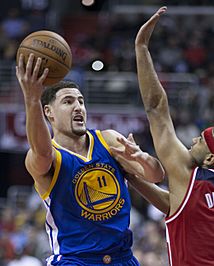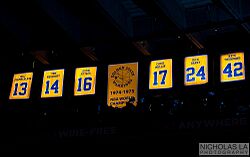Golden State Warriors facts for kids
Quick facts for kids Golden State Warriors |
|||
|---|---|---|---|
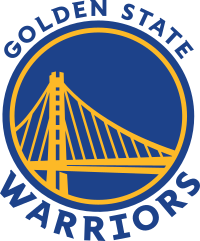 |
|||
| Conference | Western | ||
| Division | Pacific | ||
| Founded | 1946 | ||
| History | Philadelphia Warriors 1946–1962 San Francisco Warriors 1962–1971 Golden State Warriors 1971–present |
||
| Arena | Chase Center | ||
| Location | San Francisco, California | ||
| Team colors | Royal blue, yellow, black |
||
| Main sponsor | Rakuten | ||
| President | Brandon Schneider | ||
| General manager | Mike Dunleavy Jr. | ||
| Head coach | Steve Kerr | ||
| Ownership | Joe Lacob (majority) Peter Guber |
||
| Affiliation(s) | Santa Cruz Warriors | ||
| Championships | 7 (1947, 1956, 1975, 2015, 2017, 2018, 2022) | ||
| Conference titles | 7 (1975, 2015, 2016, 2017, 2018, 2019, 2022) | ||
| Division titles | 12 (1948, 1951, 1956, 1964, 1967, 1975, 1976, 2015, 2016, 2017, 2018, 2019) | ||
| Retired numbers | 7 (9, 13, 14, 16, 17, 24, 42) | ||
|
|||
The Golden State Warriors are a professional basketball team located in San Francisco, California. They play in the National Basketball Association (NBA) as part of the Western Conference's Pacific Division. The team started in Philadelphia in 1946. In 1962, they moved to the San Francisco Bay Area and became the San Francisco Warriors. In 1971, they changed their name to Golden State. Today, their home games are played at the Chase Center.
The Warriors won their first championship in 1947, when the league was called the Basketball Association of America (BAA). They won again in 1956, led by famous players like Paul Arizin, Tom Gola, and Neil Johnston. After a tough period in the mid-1960s, they drafted Rick Barry. Barry, along with Jamaal Wilkes, helped the Warriors win their third championship in 1975. This win was a big surprise to many basketball fans.
In the 1980s, the team faced challenges. But in the early 1990s, stars Tim Hardaway, Mitch Richmond, and Chris Mullin formed a popular trio known as "Run TMC". More recently, with amazing players like Stephen Curry, Klay Thompson, and Draymond Green, the Warriors won championships in 2015, 2017, 2018, and 2022. In 2016, they set an NBA record for the most wins in a regular season with 73 victories.
The Warriors are sometimes called "the Dubs," which is short for "W's." They hold several NBA records, including the best regular season record ever. Stephen Curry and Klay Thompson are known as one of the best backcourt duos in basketball history. The Warriors have won the third-most NBA championships and made the third-most Finals appearances, behind only the Los Angeles Lakers and Boston Celtics. Only Wilt Chamberlain and Stephen Curry have won the league MVP award for the team.
Contents
- Team History
- Team Colors and Logos
- Team Rivalries
- Media Coverage
- Season-by-Season Records
- Home Arenas
- Head Coaches
- Team Personnel
- Team Records and Awards
- See also
Team History
Starting in Philadelphia (1946–1962)
The Warriors began in 1946 as the Philadelphia Warriors. They were one of the first teams in the Basketball Association of America (BAA). The team was owned by Peter A. Tyrrell, who hired Eddie Gottlieb as coach and general manager. The team was named after an older Philadelphia basketball team.
Led by star player Joe Fulks, the Warriors won the first-ever BAA championship in the 1946–47 season. They beat the Chicago Stags. The NBA, which formed later, recognizes this as its first championship. Gottlieb bought the team in 1951.
The Warriors won their second championship in Philadelphia in the 1955–56 season. They defeated the Fort Wayne Pistons. Key players from this time included future Hall of Famers Paul Arizin, Tom Gola, and Neil Johnston.
The Wilt Chamberlain Years (1959–1965)
In 1959, the team signed Wilt Chamberlain, a player who would become a legend. Known as "Wilt the Stilt," he quickly broke many NBA scoring records. He changed how basketball was played. On March 2, 1962, Chamberlain scored an incredible 100 points in a single game against the New York Knicks. This is still an NBA record and one of the league's most famous moments.
In 1962, the team moved to the San Francisco Bay Area and became the San Francisco Warriors. They played games in different cities like Daly City, San Francisco, Oakland, and San Jose. Philadelphia soon got a new NBA team when the Syracuse Nationals moved there and became the Philadelphia 76ers.
Before the 1963–64 season, the Warriors drafted Nate Thurmond to play alongside Chamberlain. The Warriors won their division that season but lost the 1964 NBA Finals to the Boston Celtics. In 1965, Chamberlain was traded to the Philadelphia 76ers.
The Thurmond and Barry Era (1965–1978)
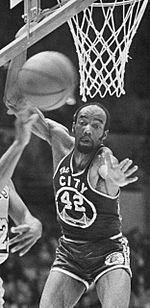
In 1965, the Warriors drafted Rick Barry, who became the NBA Rookie of the Year. He led the team to the 1967 NBA Finals, where they lost to Chamberlain's 76ers. Barry then left to play in a different league for a few years. He returned to the Warriors in 1972.
While Barry was away, Nate Thurmond, Jeff Mullins, and Rudy LaRusso led the team. The Warriors started playing more home games in Oakland. The 1970–71 season was their last as the San Francisco Warriors.
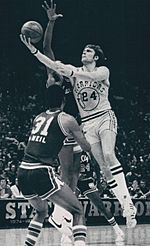
Before the 1971–72 season, the team changed its name to the Golden State Warriors. This name was chosen to show that the team represented the entire state of California. Most home games were played in Oakland, which became their main home court.
The Warriors made the playoffs often from 1971 to 1977. In 1975, they won their first NBA championship on the West Coast. Many people consider this one of the biggest upsets in NBA history. Golden State, coached by former Warrior Al Attles and led by Rick Barry and Jamaal Wilkes, swept the favored Washington Bullets in four games. Barry was named the Finals MVP.
In the 1975–76 season, the Warriors had the best record in the league. However, they were upset by the Phoenix Suns in the Western Conference Finals.
Challenging Times (1978–1985)
After losing key players like Barry, Wilkes, and Thurmond, the Warriors struggled from 1978 to 1987. They tried to rebuild by drafting players like Purvis Short and Joe Barry Carroll. They also traded Robert Parish to the Boston Celtics in 1980.
The team changed coaches several times during this period. New owners Jim Fitzgerald and Dan Finane aimed to improve the team. They hired George Karl as head coach in 1986 and drafted Chris Mullin in 1985.
The "Run TMC" Era (1985–1997)
Under coach Karl, the team improved. A famous playoff game in 1987 saw Warriors' star Sleepy Floyd score 29 points in one quarter. This performance helped increase interest in the NBA in the Bay Area.
New coach Don Nelson led the team to more wins in the late 1980s and early 1990s. He had a high-scoring trio: point guard Tim Hardaway, guard Mitch Richmond, and forward Chris Mullin. They were nicknamed "Run TMC" after a famous rap group. This trio played together for two seasons and won one playoff series.
In 1993–94, with rookie Chris Webber and Latrell Sprewell, the Warriors made the playoffs. However, problems between Webber, Sprewell, and coach Nelson led to all three leaving the team. The team then went through a difficult period. Chris Cohan became the new owner in 1994.
Tough Years and "We Believe" (1997–2009)
The Warriors changed their team colors and logos in 1997. The team continued to struggle, missing the playoffs for many years. In 1997, Sprewell was suspended for an incident with coach P. J. Carlesimo.
Despite drafting talented players like Jason Richardson, Antawn Jamison, and Gilbert Arenas, the team couldn't make the playoffs. They faced challenges with player contracts and injuries. In 2003, Chris Mullin became the executive vice president of basketball operations. He aimed to build a winning team around Richardson, Mike Dunleavy Jr, and Troy Murphy. He also drafted 7-foot center Andris Biedriņš. In 2005, the team acquired point guard Baron Davis, who brought new energy.
The 2005–06 season started well, but injuries hurt their chances. The Warriors missed the playoffs for 12 seasons in a row. In 2006, Don Nelson returned as head coach. In January 2007, a trade brought Al Harrington and Stephen Jackson to the team. This made the Warriors faster and more athletic.
The team's slogan became "We Believe" as they made a strong push at the end of the 2006–07 season. Led by Baron Davis, Jason Richardson, and Monta Ellis, the Warriors made the playoffs. They faced the top-seeded Dallas Mavericks in the first round. The Warriors, as the No. 8 seed, upset the No. 1 seed Mavericks in six games. This was a huge surprise and a historic moment in NBA playoff history.
In the next round, they lost to the Utah Jazz. In the 2007–08 season, despite winning 48 games, the Warriors missed the playoffs because the Western Conference was very strong. Every playoff team that year won at least 50 games.
In 2008, Baron Davis left the team. The Warriors drafted Anthony Randolph and signed Corey Maggette. The 2008–09 season was disappointing, with many injuries.
The Stephen Curry Era Begins (2009–Present)
Building a New Team (2009–2012)
The Warriors drafted future superstar point guard Stephen Curry in 2009. Larry Riley became the new general manager. The team continued to face injuries in the 2009–10 season. They traded Stephen Jackson and signed players like Anthony Tolliver. Curry finished second in the NBA Rookie of the Year voting.
In 2010, the Warriors drafted Ekpe Udoh. They also updated their logo and uniforms, bringing back a classic look. They traded for high-scoring forward David Lee. In July 2010, Joe Lacob and Peter Guber bought the Warriors for a record $450 million. Jeremy Lin also joined the team, becoming the first Taiwanese-American player in NBA history. Coach Don Nelson resigned, and Keith Smart became the new head coach.
The Warriors won 36 games in 2010–11 but missed the playoffs. Dorell Wright set a franchise record for three-pointers made in a season. After the season, Smart was replaced by Mark Jackson as head coach.
In the 2011 NBA draft, the Warriors selected future All-Star shooting guard Klay Thompson. The 2011–12 season was shortened by a lockout, and the team finished with a 23–43 record. Monta Ellis was traded, which allowed Stephen Curry and David Lee to become team leaders. Thompson moved into a starting role. However, Curry suffered several ankle and foot injuries that limited his playing time.
Rising to Prominence (2012–2014)
The Warriors made important moves in the 2012 off-season. They drafted Harrison Barnes, Festus Ezeli, and Draymond Green. Green, in particular, became a key player for the team's future. Curry signed a contract extension, which was seen as risky at the time due to his injuries. However, this contract later helped the team keep other strong players.
Despite injuries, the 2012–13 Warriors had one of their best starts in years. They won 20 games in less than 30 games played for the first time since 1992. The team clinched a playoff spot for the first time since the "We Believe" season. They finished with a 47–35 record and defeated the Denver Nuggets in the first round of the playoffs. They then lost to the San Antonio Spurs in the second round.
Stephen Curry set an NBA record with 272 three-pointers in a season. David Lee was named an All-Star, ending the team's 16-year drought without an All-Star selection. Curry and Klay Thompson were nicknamed the "Splash Brothers" for their amazing shooting. They combined for 483 three-pointers, breaking a league record.
In the 2013 off-season, Golden State signed Andre Iguodala. To make space for his salary, they traded Richard Jefferson, Andris Biedriņš, and Brandon Rush. The Warriors also signed Marreese Speights and Jermaine O'Neal.
The 2013–14 season had ups and downs, partly due to injuries. With Iguodala back, the Warriors went on a 10-game winning streak, their longest since the 1975 championship year. They made trades to strengthen their bench, adding Jordan Crawford and Steve Blake.
The Warriors finished the season with a 51–31 record, winning over 50 games for only the fourth time in franchise history. They battled the Los Angeles Clippers in the first round of the playoffs, losing in a tough Game 7. Curry made his first All-Star Game appearance in 2014. Curry and Klay Thompson continued to break three-point shooting records.
The Dynasty Years (2014–2019)
Mark Jackson was fired as coach in May 2014. On May 14, 2014, the Warriors hired Steve Kerr as their new head coach. This was Kerr's first head-coach job. He was a five-time NBA champion as a player and known for his accurate three-point shooting.
The Warriors had an incredible 2014–15 regular season, finishing with a league-best 67–15 record. This set a new franchise record for wins. On May 4, Stephen Curry was named the NBA Most Valuable Player, the first Warrior to win the award since Wilt Chamberlain in 1960.
In the playoffs, the Warriors swept the New Orleans Pelicans, defeated the Memphis Grizzlies, and beat the Houston Rockets. They reached their first NBA Finals since 1975. They faced the Cleveland Cavaliers. After falling behind 2–1 in the series, Coach Kerr made a key change, starting Andre Iguodala. This "Death Lineup" helped turn the series around. The Warriors defeated the Cavaliers in six games, and Iguodala was named Finals MVP. Kerr became the first rookie coach to win a title since 1982.
Stephen Curry broke his own record for three-pointers in a season with 286. He and Klay Thompson combined for 525 three-pointers, the most by any duo in NBA history. Klay Thompson also set an NBA record by scoring 37 points in one quarter.
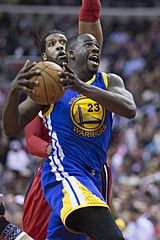
The Warriors started the 2015–16 season by winning their first 24 games, the best start in NBA history. They also set an NBA record with 54 consecutive regular-season home wins. On April 13, 2016, Golden State set the NBA record for most wins in a single season, finishing with an amazing 73–9 record. Stephen Curry was named NBA MVP for the second straight season, becoming the first player in NBA history to win the award by a unanimous vote. Curry broke many three-point records, including his own record for made three-pointers in a season with 402.
The Warriors reached the NBA Finals again, facing the Cleveland Cavaliers. They led the series 3–1 but lost in seven games.
In July 2016, Kevin Durant announced he was leaving the Oklahoma City Thunder to sign with the Golden State Warriors. This made the Warriors even stronger. They also signed David West and Zaza Pachulia.
The Warriors had many achievements in the 2016–17 season. Stephen Curry set an NBA record with 13 three-pointers in a game. Klay Thompson scored 60 points in just 29 minutes. Curry, Durant, Green, and Thompson were all named to the 2017 NBA All-Star Game, making the Warriors one of only eight teams in NBA history to have four All-Stars.
The Warriors had the best record in the 2017 playoffs, starting 12–0. They swept the Trail Blazers, Jazz, and Spurs. In the 2017 Finals, they faced the Cavaliers again, becoming the first teams to meet in the Finals three years in a row. The Warriors won the championship, going 4–1 in the Finals. Their 16–1 playoff record was the best winning percentage in NBA playoff history.
In the 2018 playoffs, the Warriors were the second seed. They defeated the Spurs and Pelicans. They then faced the Houston Rockets in the Western Conference Finals, winning in seven games. The 2018 Finals saw the Warriors play the Cavaliers for a fourth straight year, a first in NBA history. The Warriors swept the Cavaliers to win their second straight NBA championship. After this win, many sports writers called the Warriors a "dynasty." The Warriors reached the Finals again in 2019 but lost to the Toronto Raptors.
Moving to San Francisco and Injury Challenges (2019–2021)
In 2014, the Warriors began plans for a new 18,000-seat arena in Mission Bay, San Francisco. The new arena, called Chase Center, was ready for the 2019–20 NBA season. The team decided to remain the Golden State Warriors despite moving to San Francisco.
After the 2019 Finals loss, Kevin Durant left to sign with the Brooklyn Nets. The Warriors traded Durant for D'Angelo Russell. They also had to trade Andre Iguodala.
The Warriors played their first regular-season game at Chase Center on October 24, 2019. Soon after, Stephen Curry broke his hand, and Klay Thompson was out for the entire year with an injury. These injuries caused the team to struggle. They finished the 2019–20 season with the worst record in the league (15–50).
In the 2020 NBA draft, the Warriors selected James Wiseman. Just before the 2020–21 season, Klay Thompson suffered another serious injury, an Achilles tendon tear, which meant he would miss a second straight season. Stephen Curry had a great season, winning his second scoring title. However, the Warriors were eliminated in the new NBA play-in tournament, missing the playoffs for the second year in a row.
Championship Glory (2021–2022)
In the 2021 NBA draft, the Warriors selected Jonathan Kuminga and Moses Moody. They re-signed Stephen Curry to a large contract extension. They also brought back Andre Iguodala.
On April 10, 2022, the Warriors secured the third seed in the Western Conference, making the playoffs for the first time since 2019. They defeated the Denver Nuggets and the Memphis Grizzlies. On May 26, 2022, the Warriors advanced to their twelfth NBA Finals in franchise history after beating the Dallas Mavericks. On June 16, 2022, the team won their seventh NBA title, defeating the Boston Celtics 4–2. Curry, Thompson, Green, and Iguodala all won their fourth championship together.
Recent Seasons (2022–2025)
The 2022–23 season was challenging due to many injuries to key players like Stephen Curry, Klay Thompson, and Draymond Green. Despite this, the team showed great determination. They finished with the sixth seed and made the playoffs. In the first round, they defeated the Sacramento Kings in seven games, even after being down 2–0. However, they lost to the Los Angeles Lakers in six games in the Western Conference semifinals. This was their first playoff series loss before the Finals under Steve Kerr.
In the 2023–24 season, the Warriors finished with a 46–36 record, placing fifth in the Pacific Division. They did not qualify for the playoffs that year.
For the 2024–25 season, the Warriors finished with a 48–34 record, securing third place in the Pacific Division. They made it to the conference semifinals but lost to the Minnesota Timberwolves in five games.
Team Colors and Logos
Philadelphia Era Uniforms
As the Philadelphia Warriors, their uniforms usually had "PHILA" on the front. Home uniforms were white, and road uniforms were blue with gold. Sometimes, red was added.
San Francisco: "The City" Look
When they moved to San Francisco in 1962, the Warriors used similar uniforms. For the first season, road uniforms were gold with blue letters. Later, the colors were swapped.
From 1964 to 1966, the uniforms changed to block letters for the team name. The home uniform became gold.
After that, they wore what is now called "The CITY" uniform. This design featured a picture of the Golden Gate Bridge inside a circle on the front. A cable car was on the back. The team name was written on the side stripes.
California Outline (1971–1988)
When they moved to Oakland and became the Golden State Warriors in 1971, their uniforms changed. They featured "Golden State" in a Western-style font above a circle with the outline of California. A star showed the San Francisco Bay Area. This uniform was used until 1975.
Later, the team name was in Western-style letters with a fancier number design. The home uniform changed back to white before the 1986–87 season.
Run TMC Era Uniform (1988–1997)
In 1988, the Warriors updated their uniform again. The team name was written diagonally on the front. The "California outline" logo moved to the left leg of the shorts. This uniform was used during the "Run TMC" era.
Thunder Era (1997–2010)
The Warriors' look changed a lot in the 1997–98 season. They used dark navy blue, bright gold, and orange. The uniforms had lightning bolt designs. The "Warriors" wordmark had a lightning bolt over the "W."
Later, the lightning bolt stripes were removed, replaced by a thick orange stripe. The "Warriors" wordmark on the white uniform became navy blue. An orange alternate uniform was added in 2004–05.
Return to Classic Look (2010–2017)
In 2010, the Warriors went back to a modern version of "The CITY" uniform. This time, the logo included the San Francisco–Oakland Bay Bridge. The uniforms also had stripes inspired by the bridge's cables.
The Warriors also introduced gold sleeved alternate uniforms. These had a white picture of the "Bay Bridge" logo behind a diagonal "Warriors" wordmark. Later, a white sleeved version was added. In 2014–15, a gray sleeved uniform was used. A red version was worn for Chinese New Year.
For the 2016–17 season, the Warriors wore a blue "Crossover" uniform, inspired by the 1990s Run TMC-era uniforms.
Nike Era (2017–Present)
When the Warriors switched to Nike in 2017, they kept their main uniforms. The white became the "Association" uniform, and the blue became the "Icon" uniform. From 2017 to 2019, their gray "Statement" uniform featured Oakland's oak tree logo, honoring the city as "The Town."
On June 12, 2019, the Warriors updated their main logo and uniforms. The blue "Icon" uniform now had the "Bay Bridge" logo in its original colors. The "Statement" uniform became gold and featured "The Bay" with a sunset illustration, celebrating the team's return to San Francisco. In 2022, the "Statement" uniform changed to navy blue with "Golden State" in block letters. Before the 2024–25 season, the "Statement" uniform became black with "Golden" and "State" around the number. A new "W" logo was also released.
City and Earned Uniforms
In 2017–18, the Warriors wore gold "City" uniforms with "The Bay" and a dragon silhouette over the Golden Gate Bridge. This honored the Bay Area's Chinese American community. In 2018–19, a navy blue version was worn.
The Warriors received an "Earned" uniform in 2018 for making the playoffs. Their first "Earned" uniform was a gold version of "The Town" uniform. After moving to San Francisco in 2019, they used these uniforms as a "City" uniform to honor Oakland.
For the 2020–21 season, the "City" uniform honored the "We Believe" era in Oakland. It had the same colors and the "Oakland" name.
The 2021–22 "City" uniform was a mix of past team looks. The black base honored "The Town" uniforms. Blue-trimmed gold lightning bolt stripes came from the 2000s uniforms. Block numbers were from the late 1980s. The 1990s "California Outline" logo was on the belt.
The 2022–23 "City" uniform, designed by Allison Hueman, was black with a yellow rose illustration. It honored women in basketball and the community.
In the 2023–24 season, the Warriors wore a black "City" uniform to honor San Francisco. The "San Francisco" wordmark and numbers were inspired by the city's cable cars.
The "City" uniform for the 2024–25 season used the classic navy, yellow, and red colors from the early 1960s. It also nodded to the Golden Gate Bridge.
Classic Uniforms
The Warriors have worn throwback versions of "The CITY" uniforms since the 1990s. They also wore other throwback uniforms to celebrate great moments, like the 1975 championship uniforms, the "Sleepy Floyd" game uniforms from 1987, and the Run TMC uniforms. For their final game in Oakland in 2019, they wore a white uniform based on the 2007 "We Believe" era uniforms.
For the 2021–22 season, the Warriors wore a "Warriors Origins" jersey. This was a modern version of their 1961–62 road uniform, which was their last season in Philadelphia. It also marked the team's 75th anniversary. The original jersey said "PHILA," but to avoid confusion with the Philadelphia 76ers, the Warriors used their team name instead. A white version of this jersey was worn in the 2024–25 season.
Team Rivalries
Cleveland Cavaliers
The rivalry between the Warriors and the Cleveland Cavaliers became very strong starting in the 2014–15 season. They met in the NBA Finals for four years in a row, which was a first in NBA history. The Warriors won three of these four Finals (2015, 2017, 2018), while the Cavaliers won in 2016.
Los Angeles Lakers
The Warriors and the Los Angeles Lakers have a long history. Both teams moved to California in the early 1960s. While there's some friendly competition due to geography, there's generally more respect between these teams and their fans compared to other California sports rivalries. Their rivalry grew in the 1970s when they met in the playoffs many times. The Lakers' recent success, especially with LeBron James joining, added more excitement to their games. The Lakers lead the all-time regular season series and playoff series against the Warriors.
Sacramento Kings
Since the Sacramento Kings moved to Sacramento in 1985, they have had a local rivalry with the Warriors. Both teams are in Northern California, about 86 miles apart. Even though both teams have been in the league for a long time, they didn't meet in the playoffs until 2023. In that series, the Warriors defeated the Kings in seven intense games. The series was very popular, drawing high TV ratings.
Media Coverage
Television Broadcasts
Bob Fitzgerald is the television play-by-play announcer for the Warriors. Former Warriors player Kelenna Azubuike provides color commentary on NBC Sports Bay Area. They broadcast over 70 Warriors games each year. They also host pre-game and post-game shows. Fitzgerald has been with the Warriors for 24 seasons, and Azubuike for 2 seasons.
Jim Barnett, a former Warriors guard, was the TV color analyst for many years. He is now the full-time color commentator on the radio.
Greg Papa and Garry St. Jean also provide analysis for pre-game, halftime, and post-game shows. Kerith Burke is the sideline reporter.
Radio Broadcasts
Tim Roye has been the radio play-by-play announcer for Warriors games since 1995. He is joined by former Warriors forward Tom Tolbert for home games. Jim Barnett also provides color analysis for both road and home games.
In 2016, the Warriors announced that their games would be broadcast on KGMZ's 95.7 The Game. After each game, Roye, Fitzgerald, and Barnett discuss the game and preview the next one.
Season-by-Season Records
Here are the last five seasons for the Warriors. For a full history, see List of Golden State Warriors seasons.
Note: GP = Games played, W = Wins, L = Losses, W–L% = Winning percentage
| Season | GP | W | L | W–L% | Finish | Playoffs |
| 2020–21 | 72 | 39 | 33 | .542 | 4th, Pacific | Did not qualify |
| 2021–22 | 82 | 53 | 29 | .646 | 2nd, Pacific | NBA champions, 4–2 (Celtics) |
| 2022–23 | 82 | 44 | 38 | .537 | 4th, Pacific | Lost in conference semifinals, 2–4 (Lakers) |
| 2023–24 | 82 | 46 | 36 | .561 | 5th, Pacific | Did not qualify |
| 2024–25 | 82 | 48 | 34 | .585 | 3rd, Pacific | Lost in conference semifinals, 1–4 (Timberwolves) |
Home Arenas
- Philadelphia Arena (1946–1962)
- Philadelphia Convention Hall (1952–1962)
- Cow Palace (1962–1964, 1966–1971, and two games in 1975 NBA Finals)
- War Memorial Gymnasium (occasional games, 1962–1967)
- San Francisco Civic Auditorium (1964–1966)
- Oakland Coliseum Arena/The Arena in Oakland/Oracle Arena (1971–2019)
- San Diego Sports Arena (six games in 1971–1972)
- San Jose Arena (1996–1997 due to renovations at Oakland Arena)
- Chase Center (2019–present)
Head Coaches
Team Personnel
Current Roster
Draft Rights Held
The Warriors hold the rights to players drafted who are currently playing outside the NBA. If these players sign with a non-NBA team, the Warriors keep their draft rights until one year after their contract with that team ends.
| Draft | Round | Pick | Player | Pos. | Nationality | Current team | Note(s) | Ref |
|---|---|---|---|---|---|---|---|---|
| 2015 | 2 | 55 | Cady Lalanne | C | Busan KCC Egis (South Korea) | Acquired from the San Antonio Spurs |
Retired Jersey Numbers
The Warriors honor special players by retiring their jersey numbers. This means no other player on the team can wear that number.
| Golden State Warriors Retired Numbers | ||||
|---|---|---|---|---|
| No. | Player | Position | Years Played | Date Retired |
| 9 | Andre Iguodala | G/F | 2013–2019 2021–2023 |
February 23, 2025 |
| 13 | Wilt Chamberlain | C | 1959–1965 1 | December 29, 1999 |
| 14 | Tom Meschery | F | 1961–1967 2 | October 13, 1967 |
| 16 | Al Attles | G | 1960–1971 3 | February 10, 1977 |
| 17 | Chris Mullin | G/F | 1985–1997 2000–2001 4 |
March 19, 2012 |
| 24 | Rick Barry | F | 1965–1967 1972–1978 |
March 18, 1988 |
| 42 | Nate Thurmond | C | 1963–1974 | March 8, 1978 |
Notes:
- 1 Includes Chamberlain's time (1959–1962) in Philadelphia; retired after his death.
- 2 Includes Meschery's time (1961–1962) in Philadelphia.
- 3 Includes Attles' time (1960–1962) in Philadelphia. He also coached the team (1969–1983).
- 4 Also served as the team's general manager (2004–2009).
- Meschery, Attles, Barry, Thurmond, and Mullin are also in the Bay Area Sports Hall of Fame.
- In July 2019, the team announced they plan to retire Kevin Durant's No. 35 jersey.
- The NBA retired Bill Russell's No. 6 for all its teams on August 11, 2022.
Hall of Fame Members
Many players, coaches, and contributors from the Warriors have been inducted into the Naismith Memorial Basketball Hall of Fame.
| Golden State Warriors Hall of Famers | |||||||||
|---|---|---|---|---|---|---|---|---|---|
| Players | |||||||||
| No. | Name | Position | Years Played | Inducted | No. | Name | Position | Years Played | Inducted |
| 17 | Andy Phillip | G/F | 1950–1953 | 1961 | 15 | Tom Gola | F/G | 1955–1962 | 1976 |
| 10 | Joe Fulks | F | 1946–1954 | 1978 | 11 | Paul Arizin | F/G | 1950–1962 | 1978 |
| 13 | Wilt Chamberlain | C | 1959–1965 | 1978 | 32 47 |
Jerry Lucas 2 | F/C | 1969–1971 | 1980 |
| 42 | Nate Thurmond | F/C | 1963–1974 | 1985 | 24 | Rick Barry | F | 1965–1967 1972–1978 |
1987 |
| 6 | Neil Johnston | C | 1951–1959 | 1990 | 00 | Robert Parish | C | 1976–1980 | 2003 |
| 17 | Chris Mullin 1 | G/F | 1985–1997 2000–2001 |
2011 | 41 | Jamaal Wilkes | F | 1974–1977 | 2012 |
| 50 | Ralph Sampson | C/F | 1987–1989 | 2012 | 30 | Bernard King | F | 1980–1982 | 2013 |
| 5 25 |
Guy Rodgers | G | 1958–1966 | 2014 | 23 | Mitch Richmond | G | 1988–1991 | 2014 |
| 13 | Šarūnas Marčiulionis | G | 1989–1994 | 2014 | 10 | Jo Jo White | G | 1979–1980 | 2015 |
| 4 | Chris Webber | F | 1993–1994 2008 |
2021 | 5 10 |
Tim Hardaway | G | 1989–1996 | 2022 |
| Coaches | |||||||||
| Name | Position | Years Coached | Inducted | Name | Position | Years Coached | Inducted | ||
| Frank McGuire | Head coach | 1961–1962 | 1977 | Alex Hannum | Head coach | 1963–1966 | 1998 | ||
| Bill Sharman | Head coach | 1966–1968 | 2004 | Don Nelson | Head coach | 1988–1995 2006–2010 |
2012 | ||
| Rick Adelman | Head coach | 1995–1997 | 2021 | George Karl | Head coach | 1986–1988 | 2022 | ||
| Gregg Popovich | Assistant coach | 1992–1994 | 2023 | ||||||
| Contributors | |||||||||
| Name | Position | Years with Team | Inducted | Name | Position | Years with Team | Inducted | ||
| Eddie Gottlieb | Founder Owner |
1946–1962 | 1972 | Pete Newell 3 | Scout | 1977–1984 | 1979 | ||
| Rick Welts | Executive | 2011–2024 | 2018 | 16 | Al Attles | Player Coach Executive |
1960–2024 | 2019 | |
| 5 18 |
Larry Costello | G | 1954–1955 1956–1957 |
2022 | Jerry West | Executive | 2011–2017 | 2024 | |
Notes:
- 1 Mullin was inducted twice: as a player and as a member of the 1992 Olympic team.
- 2 Lucas was inducted twice: as a player and as a member of the 1960 Olympic team.
- 3 Newell was inducted twice: as a contributor and as a member of the 1960 Olympic team.
FIBA Hall of Famers
| Golden State Warriors Hall of Famers | ||||
|---|---|---|---|---|
| Players | ||||
| No. | Name | Position | Years Played | Inducted |
| 13 | Šarūnas Marčiulionis | G | 1989–1994 | 2015 |
Team Records and Awards
Career Leaders
| Category | Player | Statistics |
|---|---|---|
| Seasons Played | Stephen Curry | 16 |
| Games Played | Stephen Curry | 1,026 |
| Minutes Played | Stephen Curry | 34,975 |
| Points | Stephen Curry | 25,386 |
| Rebounds | Nate Thurmond | 12,771 |
| Assists | Stephen Curry | 6,540 |
| Steals | Stephen Curry | 1,553 |
| Blocks | Adonal Foyle | 1,140 |
| Turnovers | Stephen Curry | 3,187 |
| Personal Fouls | Paul Arizin | 2,764 |
| Field Goals | Stephen Curry | 8,648 |
| Field Goal Attempts | Stephen Curry | 18,356 |
| Field Goal % | Andris Biedriņš | .594 |
| 2-Pointers Made | Wilt Chamberlain | 7,216 |
| 2-Point Attempts | Rick Barry | 14,392 |
| 2-Point % | Gary Payton II | .708 |
| 3-Pointers Made | Stephen Curry | 4,058 |
| 3-Point Attempts | Stephen Curry | 9,589 |
| 3-Point % | Anthony Morrow | .460 |
| Free Throws Made | Paul Arizin | 5,010 |
| Free Throw Attempts | Paul Arizin | 6,189 |
| Free Throw % | Stephen Curry | .911 |
| Triple-Doubles | Draymond Green | 33 |
| Minutes Per Game | Wilt Chamberlain | 47.2 |
| Points Per Game | Wilt Chamberlain | 41.5 |
| Rebounds Per Game | Wilt Chamberlain | 25.1 |
| Assists Per Game | Tim Hardaway | 9.3 |
| Steals Per Game | Rick Barry | 2.3 |
| Blocks Per Game | Manute Bol | 3.7 |
Season Leaders
| Category | Player | Statistics |
|---|---|---|
| Minutes Played | Wilt Chamberlain | 3,882 |
| Points | Wilt Chamberlain | 4,029 |
| Rebounds | Wilt Chamberlain | 2,149 |
| Assists | Sleepy Floyd | 848 |
| Steals | Rick Barry | 228 |
| Blocks | Manute Bol | 345 |
| Turnovers | Latrell Sprewell | 322 |
| Personal Fouls | Rudy LaRusso | 337 |
| Field Goals | Wilt Chamberlain | 1,597 |
| Field Goal Attempts | Wilt Chamberlain | 3,159 |
| Field Goal % | Chris Gatling | .633 |
| 2-Pointers Made | Wilt Chamberlain | 1,597 |
| 2-Point Attempts | Wilt Chamberlain | 3,159 |
| 2-Point % | Chris Gatling | .634 |
| 3-Pointers Made | Stephen Curry | 402 |
| 3-Point Attempts | Stephen Curry | 886 |
| 3-Point % | B. J. Armstrong | .473 |
| Free Throws Made | Wilt Chamberlain | 835 |
| Free Throw Attempts | Wilt Chamberlain | 1,363 |
| Free Throw % | Stephen Curry | .934 |
| Triple-Doubles | Draymond Green | 13 |
| Minutes Per Game | Wilt Chamberlain | 48.5 |
| Points Per Game | Wilt Chamberlain | 50.4 |
| Rebounds Per Game | Wilt Chamberlain | 27.2 |
| Assists Per Game | Guy Rodgers | 10.7 |
| Steals Per Game | Rick Barry | 2.9 |
| Blocks Per Game | Manute Bol | 4.3 |
Individual Awards
- Wilt Chamberlain – 1960
- Stephen Curry – 2015, 2016
- Rick Barry – 1975
- Andre Iguodala – 2015
- Kevin Durant – 2017, 2018
- Stephen Curry – 2022
NBA Defensive Player of the Year
- Draymond Green – 2017
NBA Rookie of the Year
- Woody Sauldsberry – 1958
- Wilt Chamberlain – 1960
- Rick Barry – 1966
- Jamaal Wilkes – 1975
- Mitch Richmond – 1989
- Chris Webber – 1994
NBA Most Improved Player
- Gilbert Arenas – 2003
- Monta Ellis – 2007
NBA Western Conference Finals MVP
- Stephen Curry – 2022
NBA Clutch Player of the Year
- Stephen Curry – 2024
Twyman–Stokes Teammate of the Year
- Stephen Curry – 2025
NBA Sportsmanship Award
- Stephen Curry – 2011
NBA Hustle Award
- Draymond Green – 2025
Kareem Abdul-Jabbar Social Justice Champion
- Stephen Curry – 2023
J. Walter Kennedy Citizenship Award
- Stephen Curry – 2023
NBA Community Assist Award
- Stephen Curry – 2014
- Kevin Durant – 2018
- Gary Payton II – 2022
NBA Executive of the Year
- Dick Vertlieb – 1975
- Bob Myers – 2015, 2017
NBA Coach of the Year
- Alex Hannum – 1964
- Don Nelson – 1992
- Steve Kerr – 2016
All-NBA First Team
- Joe Fulks – 1947–1949
- Howie Dallmar – 1948
- Paul Arizin – 1952, 1956, 1957
- Neil Johnston – 1953–1956
- Wilt Chamberlain – 1960–1962, 1964
- Rick Barry – 1966, 1967, 1974–1976
- Chris Mullin – 1992
- Latrell Sprewell – 1994
- Stephen Curry – 2015, 2016, 2019, 2021
- Kevin Durant – 2018
All-NBA Second Team
- Joe Fulks – 1951
- Andy Phillip – 1952, 1953
- Jack George – 1956
- Neil Johnston – 1957
- Tom Gola – 1958
- Paul Arizin – 1959
- Wilt Chamberlain – 1963
- Rick Barry – 1973
- Phil Smith – 1976
- Bernard King – 1982
- Chris Mullin – 1989, 1991
- Tim Hardaway – 1992
- Stephen Curry – 2014, 2017, 2022, 2023, 2025
- Draymond Green – 2016
- Kevin Durant – 2017, 2019
All-NBA Third Team
- Chris Mullin – 1990
- Tim Hardaway – 1993
- David Lee – 2013
- Klay Thompson – 2015, 2016
- Draymond Green – 2017
- Stephen Curry – 2018, 2024
NBA All-Defensive First Team
- Nate Thurmond – 1969, 1971
- Andre Iguodala – 2014
- Draymond Green – 2015–2017, 2021, 2025
NBA All-Defensive Second Team
- Rudy LaRusso – 1969
- Nate Thurmond – 1972–1974
- Phil Smith – 1976
- Jamaal Wilkes – 1976, 1977
- E.C. Coleman – 1978
- Latrell Sprewell – 1994
- Andrew Bogut – 2015
- Draymond Green – 2018, 2019, 2022, 2023
- Klay Thompson – 2019
NBA All-Rookie First Team
- Nate Thurmond – 1964
- Fred Hetzel – 1966
- Rick Barry – 1966
- Jamaal Wilkes – 1975
- Gus Williams – 1976
- Joe Barry Carroll – 1981
- Larry Smith – 1981
- Mitch Richmond – 1989
- Tim Hardaway – 1990
- Billy Owens – 1992
- Chris Webber – 1994
- Joe Smith – 1996
- Marc Jackson – 2001
- Jason Richardson – 2002
- Stephen Curry – 2010
- Klay Thompson – 2012
- Harrison Barnes – 2013
- Eric Paschall – 2020
- Brandin Podziemski – 2024
NBA All-Rookie Second Team
- Latrell Sprewell – 1993
- Donyell Marshall – 1995
- Antawn Jamison – 1999
NBA All-Star Weekend Honors
- Paul Arizin – 1951, 1952, 1955–1962
- Joe Fulks – 1951, 1952
- Andy Phillip – 1951, 1952
- Neil Johnston – 1953–1958
- Jack George – 1956, 1957
- Woody Sauldsberry – 1959
- Tom Gola – 1960–1962
- Wilt Chamberlain – 1960–1965
- Tom Meschery – 1963
- Guy Rodgers – 1963, 1964, 1966
- Nate Thurmond – 1965–1968, 1970, 1973, 1974
- Rick Barry – 1966, 1967, 1973–1978
- Jim King – 1968
- Clyde Lee – 1968
- Rudy LaRusso – 1968, 1969
- Jeff Mullins – 1969–1971
- Jerry Lucas – 1971
- Cazzie Russell – 1972
- Jamaal Wilkes – 1976
- Phil Smith – 1976, 1977
- Bernard King – 1982
- Sleepy Floyd – 1987
- Joe Barry Carroll – 1987
- Chris Mullin – 1989–1993
- Tim Hardaway – 1991–1993
- Latrell Sprewell – 1994, 1995, 1997
- David Lee – 2013
- Stephen Curry – 2014–2019, 2021–2025
- Klay Thompson – 2015–2019
- Draymond Green – 2016–2018, 2022
- Kevin Durant – 2017–2019
- Andrew Wiggins – 2022
NBA All-Star Game Head Coach
- Alex Hannum – 1965
- Bill Sharman – 1968
- Al Attles – 1975, 1976
- Don Nelson – 1992
- Steve Kerr – 2015, 2017
NBA All-Star Game MVP
- Paul Arizin – 1952
- Wilt Chamberlain – 1960
- Rick Barry – 1967
- Kevin Durant – 2019
- Stephen Curry – 2022, 2025
Skills Challenge
- Stephen Curry – 2011
Slam Dunk Contest
- Jason Richardson – 2002, 2003
Three-Point Contest
- Stephen Curry – 2015, 2021
- Klay Thompson – 2016
NBA vs. WNBA Three-Point Challenge
- Stephen Curry – 2024
See also
 In Spanish: Golden State Warriors para niños
In Spanish: Golden State Warriors para niños


